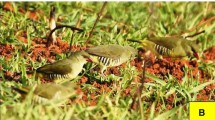Abstract
Study of Great Egret breeding success was carried out for the first time in Hara Biosphere Reserve of Iran. Since Great Egret is considered as wading bird as well as wetland-dependent species which is located on top of the food chain in this ecosystem, its breeding study is an appropriate means for evaluating food supply fluctuations and environmental threatening factors by comparison of different years. On the other hand, Great Egret is considered a suitable indicator to examination of biological changes, impact of pollutions, and other effective human activities on Hara Biosphere Reserve. Therefore, read-ahead is required for area management planning in order to maintain the health of mangrove ecosystem and control threatening factors of the sensitive biodiversity of area. The results indicate that the average breeding success of Great Egret in different stages of hatching success, fledging success, and breeding success were equal to 0.54, 0.61, and 0.50 in 2008 and 0.61, 0.59, and 0.42 in 2009, respectively.
Similar content being viewed by others
References
Amini Nasab, S. M., Behrouzi Rad, B., & Riahi Bakhtiari, A. R. (2007). Reproductive phonology and breeding success on the whiskered tern (Chlidonias hybridus) in Zarrinkola and Marzoonabad Permanent Ab-bandans of Mazandaran Province Iran. Journal of Environmental Study, 33, 89–102.
Barati, A., Javav, S., & Sehhatisabet, M. (2008). Reproductive biology of Pygmy Cormorant (Phalaccroax pygmeus) in Siahkeshim protected area, Northern Iran. Marine Ornithology, 36, 163–166.
Brown, M., & Sandwith, M. (2007). Cuckoo—Shrikes to thrushes. In J. del Hoyo, A. Elliott, & D. Christie (Eds.), Handbook of the birds of the world (Vol. 10). Spain: Lynx Edicions.
Chapman, B. R., & Howard, R. J. (1984). Habitat suitability index models: Great Egret. USA: US Fish and Wildlife Service, FWS/OBS-82/10.78.
Custer, T. W., & Frederick, P. C. (1990). Egg size and laying order of Snowy Egrets, Great Egret, and Black-Crowned Night-Herons. The Condor, 92, 772–775.
Dehghani, M., Farshchi, P., Danekar, A., Karami, M., & Aleshikh, A. A. (2010). Recreation value of Hara Biosphere Reserve using willingness-to-pay method. International Journal of Environmental Research, 4(2), 271–280.
Firouz, E. (2005). The complete fauna of Iran (pp. 352). London: I.B. Tauris.
Gill, F., & Wright, M. (2006). Birds of the world: Recommended English names (p. 272). The International Ornithological Congress.
Holloway, S. L., Glotzer, M., King, R. W., & Murray, A. W. (1993). Anaphase is initiated by proteolysis rather than by the inactivation of maturation-promoting factors. Cell, 73(7), 1393–1402.
Kaboli, M., Karami, M., & Kiabi, H. B. (2006). A study of the factors affecting the breeding success of marsh harrier (Circus aeruginosus) as an umbrella species in Aji-Gol, Ala-Gol and Alma-Gol International Wetlands of Turkmen Steppe, Iran. Iranian Journal of Natural Resources, 59, 669–680.
Macnae, W. (1969). A general account of the fauna and flora of mangrove swamps and forests in the Indo-West-Pacific Region. Advances in Marine Biology, 6, 73–103.
Mokhtari, M., Savari, A., Rezai, H., Kochanian, P., & Bitaab, A. (2008). Population ecology of fiddler crab, Uca lactea annulipes (Decapoda: Ocypodidae) in Sirik mangrove estuary, Iran. Estuarine, Coastal and Shelf Science, 76(2), 273–281.
Pak, A., & Farajzadeh, M. (2007). Iran’s integrated coastal management plan: Persian Gulf, Oman Sea, and southern Caspian Sea coastlines. Ocean & Coastal Management, 50(9), 754–773.
Penrose, P., Sasekumar, A., & Somerfield, P. J. (2008). The habitat function of mangroves for terrestrial and marine fauna: A review. Aquatic Botany, 89(2), 155–185.
Powell, G. V. N., & Harriett Powell, A. (1986). Reproduction by great white herons Ardea herodias in Florida Bay as an indicator of habitat quality. Biological Conservation, 36(2), 101–113.
Seto, K. C., & Fragkias, M. (2007). Mangrove conversion and aquaculture development in Vietnam: A remote sensing-based approach for evaluating the Ramsar Convention on Wetlands. Global Environmental Change, 17(3–4), 486–500.
Si Bachir, A., Barbraud, C., Doumandji, S., & Hafner, H. (2008). Nest site selection and breeding success in an expanding species, the cattle egret (Bubulcus ibis). Ardea, 96(1), 99–107.
Smith, J. P. (1997). An energy-circuit population model for Great Egrets (Ardea alba) at Lake Okeechobee, Florida, USA. Ecological Modeling, 97(1–2), 1– 21.
Sutherland, W. J., Newton, L., & Green, R. E. (2004). Bird ecology and conservation a handbook of techniques. Oxford: University Press.
Zahed, M. A., Ruhani, F., & Mohajeri, S. (2010). An overview of Iranian mangrove ecosystem, Northern Part of the Persian Gulf and Oman Sea. Acta Ecologica Sinica, 9(2), 411–417.
Author information
Authors and Affiliations
Corresponding author
Rights and permissions
About this article
Cite this article
Neinavaz, E., Karami, M. & Danehkar, A. Investigation of Great Egret (Casmerodius albus) breeding success in Hara Biosphere Reserve of Iran. Environ Monit Assess 179, 301–307 (2011). https://doi.org/10.1007/s10661-010-1737-4
Received:
Accepted:
Published:
Issue Date:
DOI: https://doi.org/10.1007/s10661-010-1737-4




